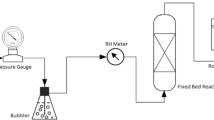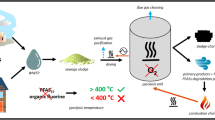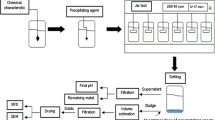Abstract
Simultaneous TG/DSC-FT-IR was employed to study the effect of catocene with a high concentration (5, 15, and 25 %) on the thermal decomposition of ammonium perchlorate (AP) and octogen (HMX) with different particle sizes. The experimental results show that catocene has effect on the thermal decomposition of AP and HMX, but the role that catocene playing changes with the concentration of catocene and the particle size of AP and HMX. High concentration of catocene (more than 15 %) benefits the decomposition of fine AP and HMX at low temperature, but has little effect on the decomposition of median and coarse AP. The thermal decomposition of HMX is affected by catocene mainly through increasing the heat release of the first decomposition step, while through both increasing the heat release and decreasing the decomposition temperature of the first decomposition step for the thermal decomposition of AP.



















Similar content being viewed by others
References
Kuo KK, Summerfield M. Fundamentals of solid-propellant combustion. New York: American Institute of Aeronautics and Astronautics; 1984.
Menke K, Eisele S. Rocket propellants with reduced smoke and high burning rates. Propellant Explos Pyrotech. 1997;22(3):112–9. doi:10.1002/prep.19970220304.
Yang V, Brill TB, Ren WZ, Zarchan P. Solid propellant chemistry, combustion, and motor interior ballistics, vol. 185. New York: American Institute of Aeronautics and Astronautics; 2000.
Saravanakumar D, Sengottuvelan N, Narayanan V, Kandaswamy M, Varghese TL. Burning-rate enhancement of a high-energy rocket composite solid propellant based on ferrocene-grafted hydroxyl-terminated polybutadiene binder. J Appl Polym Sci. 2011;119(5):2517–24. doi:10.1002/App.32859.
Guo XD, Li FS, Song HC, Liu GP, Kong LR, Li MN, et al. Combustion characteristics of a novel grain-binding high burning rate propellant. Propellant Explos Pyrotech. 2008;33(4):255–60. doi:10.1002/prep.200800223.
Kishore K, Verneker VRP, Sunitha MR. Mechanistic studies on the pyrolysis and combustion of polystyrene-ammonium perchlorate propellants in the presence of transition-metal oxides. J Anal Appl Pyrolysis. 1980;2(2):169–74. doi:10.1016/0165-2370(80)80027-1.
Gore GM, Tipare KR, Bhatewara RC, Prasad US, Gupta M, Mane SR. Evaluation of ferrocene derivatives as burn rate modifiers in AP/HTPB-based composite propellants. Def Sci J. 1999;49(2):151–8.
Boldyrev VV. Thermal decomposition of ammonium perchlorate. Thermochim Acta. 2006;443(1):1–36. doi:10.1016/j.tca.2005.11.038.
Singh G, Kapoor IPS, Dubey S, Siril PF, Yi JH, Zhao FQ, et al. Effect of mixed ternary transition metal ferrite nanocrystallites on thermal decomposition of ammonium perchlorate. Thermochim Acta. 2008;477(1–2):42–7. doi:10.1016/j.tca.2008.08.005.
Kapoor IPS, Srivastava P, Singh G. Nanocrystalline transition metal oxides as catalysts in the thermal decomposition of ammonium perchlorate. Propellant Explos Pyrotech. 2009;34(4):351–6. doi:10.1002/prep.200800025.
Fujimura K, Miyake A. Effect of the particle size and specific surface area of ferric oxide catalyst on the burning rate of AP/HTPB solid propellant. Sci Technol Energ Mater. 2010;71(3–4):65–9.
Xiao FJ, Luo YJ. Ferrocene containing hyperbranched polyester: structure and catalytic performance for thermal decomposition of ammonium perchlorate. New Adv Mater. 2011;197–198:1225–30. doi:10.4028/www.scientific.net/AMR.197-198.1225.
Florczak B. Effect of additives on properties of composite solid propellants. Przem Chem. 2012;91(9):1858–62.
Shen SM, Wang SW, Chiu YS, Chen SI, Chang FM, Huang CC. Thermal-decomposition of cured gap-Ap propellants containing catocene. Thermochim Acta. 1993;216:255–66. doi:10.1016/0040-6031(93)80396-R.
Shen SM, Chen SI, Wu BH. The Thermal-decomposition of ammonium-perchlorate (Ap) containing a burning-rate modifier. Thermochim Acta. 1993;223:135–43. doi:10.1016/0040-6031(93)80128-W.
Liu LL, He GQ, Wang YH. Thermal reaction characteristics of the boron used in the fuel-rich propellant. J Therm Anal Calorim. 2013;114(3):1057–68. doi:10.1007/s10973-013-3119-y.
Acknowledgements
This research is supported by the Doctorate Foundation of Northwestern Polytechnical University (CX201306).
Author information
Authors and Affiliations
Corresponding author
Rights and permissions
About this article
Cite this article
Liu, Ll., He, Gq., Wang, Yh. et al. Effect of catocene on the thermal decomposition of ammonium perchlorate and octogen. J Therm Anal Calorim 117, 621–628 (2014). https://doi.org/10.1007/s10973-014-3792-5
Received:
Accepted:
Published:
Issue Date:
DOI: https://doi.org/10.1007/s10973-014-3792-5




